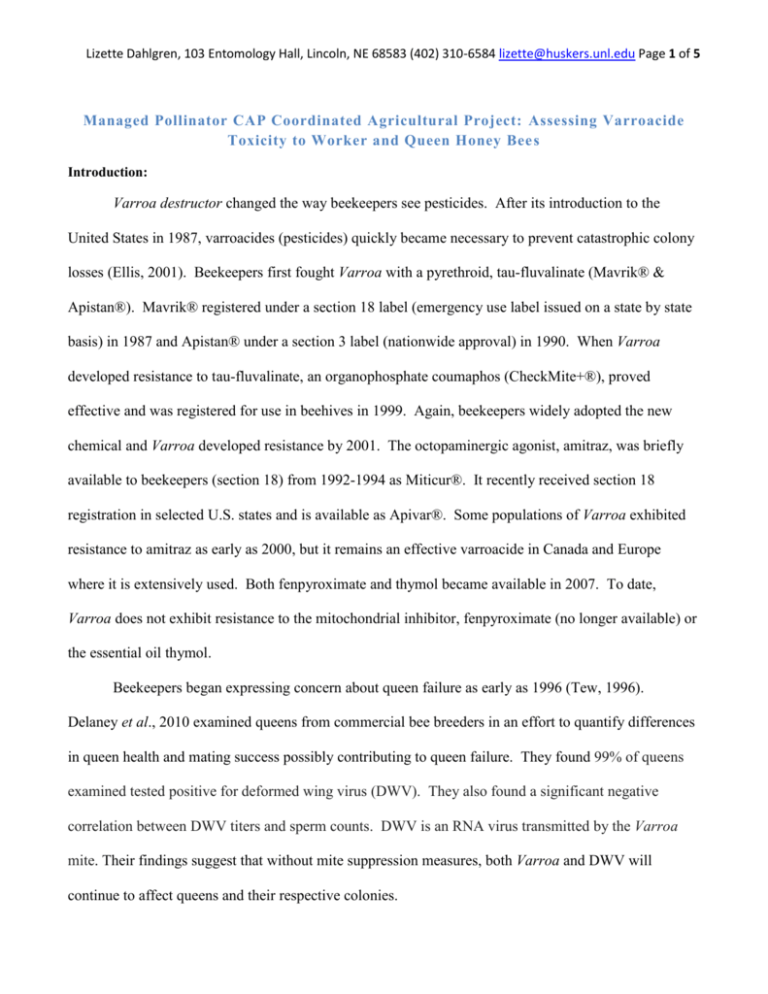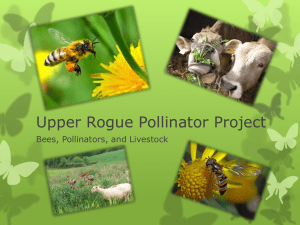Assessing Varroacide Toxicity to Worker and Queen Honey Bees
advertisement

Lizette Dahlgren, 103 Entomology Hall, Lincoln, NE 68583 (402) 310-6584 lizette@huskers.unl.edu Page 1 of 5 Managed Pollinator CAP Coordinated Agricultural Project: Assessing Varroacide Toxicity to Worker and Queen Honey Bee s Introduction: Varroa destructor changed the way beekeepers see pesticides. After its introduction to the United States in 1987, varroacides (pesticides) quickly became necessary to prevent catastrophic colony losses (Ellis, 2001). Beekeepers first fought Varroa with a pyrethroid, tau-fluvalinate (Mavrik® & Apistan®). Mavrik® registered under a section 18 label (emergency use label issued on a state by state basis) in 1987 and Apistan® under a section 3 label (nationwide approval) in 1990. When Varroa developed resistance to tau-fluvalinate, an organophosphate coumaphos (CheckMite+®), proved effective and was registered for use in beehives in 1999. Again, beekeepers widely adopted the new chemical and Varroa developed resistance by 2001. The octopaminergic agonist, amitraz, was briefly available to beekeepers (section 18) from 1992-1994 as Miticur®. It recently received section 18 registration in selected U.S. states and is available as Apivar®. Some populations of Varroa exhibited resistance to amitraz as early as 2000, but it remains an effective varroacide in Canada and Europe where it is extensively used. Both fenpyroximate and thymol became available in 2007. To date, Varroa does not exhibit resistance to the mitochondrial inhibitor, fenpyroximate (no longer available) or the essential oil thymol. Beekeepers began expressing concern about queen failure as early as 1996 (Tew, 1996). Delaney et al., 2010 examined queens from commercial bee breeders in an effort to quantify differences in queen health and mating success possibly contributing to queen failure. They found 99% of queens examined tested positive for deformed wing virus (DWV). They also found a significant negative correlation between DWV titers and sperm counts. DWV is an RNA virus transmitted by the Varroa mite. Their findings suggest that without mite suppression measures, both Varroa and DWV will continue to affect queens and their respective colonies. Lizette Dahlgren, 103 Entomology Hall, Lincoln, NE 68583 (402) 310-6584 lizette@huskers.unl.edu Page 2 of 5 Comparison of Varroacide Tolerance: The University of Nebraska’s apiculture lab recently completed a study that fulfilled a portion of our commitment to the CAP grant. The specifics are available in the Journal of Economic Entomology, December 2012 (Dahlgren et al., 2012). In this study, I compared queen and worker honey bee tolerance of varroacides. Queens are expensive and time consuming to rear. For this reason, pesticide tolerance comparisons between adult worker and adult queens are not frequently conducted. Past studies include comparisons of DDT, carbaryl, and paraquat (respectively: Graves and Mackensen,1965; Tucker, 1980; Corona et al. 2007). Interestingly, all the aforementioned studies found queens could tolerate higher doses of pesticides than workers than can be explained by weight alone. As the pesticides tested vary in mode of action (method of causing death), the results add to our understanding of differences between queen and worker pesticide tolerance. Queens were reared using Doolittle methods, caged with a drop of candy to ensure survival until they become attractive to workers (~4 days), and allowed to emerge in queen banks. Queen banks were queenless 4-5 frame nucleus colonies stocked with 1 kg of worker bees. A frame of brood was added weekly. All frames were checked for uncaged queen cells twice weekly. Workers were emerged in the incubator and brushed into cages every 24 hours. Experimental bees received a single dose of a varroacide topically applied. Doses chosen produced 0-100 % mortality with the exception of coumaphos and fenpyroximate for which the highest applied doses failed to produce reliable queen mortality. We treated worker bees aged 3-4 days and queens aged 2-5 days. Treated workers were kept in groups of 20 in wax paper cups, supplied a solution of 1:1 sugar water by weight, and returned to the incubator. Queens were recaged and returned to queen banks. Mortality was checked at 24 hr and 48 hr Lizette Dahlgren, 103 Entomology Hall, Lincoln, NE 68583 (402) 310-6584 lizette@huskers.unl.edu Page 3 of 5 timepoints for both queens and workers. Queen mortality was also checked weekly for 6 weeks after treatment. Dead queens were removed from queenbanks at the time of their discovery. Of the five varroacides I tested, queens tolerated four (coumaphos, tau-fluvalinate, thymol, and fenpyroximate) at a higher dose (mg/kg body weight) than workers. In fact, when adjusted for that weight difference, queens (averaging 180 mg) tolerated 3-times more tau-fluvalinate, 6-times more thymol, at least 12-fold more coumaphos and 40-fold more fenpyroximate than workers (averaging 108 mg). These extreme discrepancies between castes indicate physiological differences in how the two castes are affected by varroacides. There was one exception to this pattern with queens and workers being equally susceptible to amitraz. Future Direction: The varroacides that were studied kill arthropods by different modes of action and yet queens were found to be more tolerant of all varroacides tested, except amitraz, suggesting that queens possess a non-specific mechanism of varroacide tolerance. Based on this finding, I hypothesize that workers in a more ‘queen-like’ physiology will be able to better tolerate varroacides. Short lived worker bees occur in the summer, living an average of 30 days. Worker bees reared in the late fall, ‘winter bees’, must survive 3-5 months until spring. Therefore, a more ‘queen-like’ physiology in the worker caste is found in that of the ‘diutinus (Latin for long-lived) bee,’ occur in broodless periods, as ‘winter bees,’ and likely in bees preparing to swarm. Diutinus bees are characterized by increased fat body, higher vitellogenin titers, and increased longevity (280 days or more). Vitellogenin affects worker and queen longevity, temporal polyethism, and aids in immunity and stress resistance. If varroacides applied within the hive lead to a decreased vitellogenin, exposure to these compounds could result in a reduced time to foraging, increased foraging frequency, a higher frequency of nectar (as opposed to pollen) collectors, and a reduced capacity to rear brood. MacKenzie and Winston (1989) found a decreased time to foraging and a decreased lifespan of individual workers Lizette Dahlgren, 103 Entomology Hall, Lincoln, NE 68583 (402) 310-6584 lizette@huskers.unl.edu Page 4 of 5 treated with diazanon. Wu et al. (2011) found, on average, a four day lifespan reduction of bees reared in pesticide contaminated wax comb. On a more positive note, and in agreement with the restoration of vitellogenin production, Wahl and Ulm (1983) found that pollen extended the life of bees treated with pesticides. If queenliness is a factor in the tolerance of varroacides by honey bees, beekeepers may benefit by delaying applications until late fall when workers have increased fat body and vitellogenin levels. In addition, pollen, which provides necessary amino acids for synthesis of protein including vitellogenin, has been shown to influence the susceptibility to pathogens. Therefore, beekeepers may also benefit by feeding pollen mixtures or equivalent substitutes in late winter and early spring to help colonies rebuild vitellogenin levels that can improve winter survival and toxin tolerance. I will test my hypothesis in experiments conducted in the spring of 2013. I acknowledge Drs. Marion Ellis, Blair Siegfried, and Reed Johnson for their advice and guidance with the study described and ongoing research. References: Corona, M., R.A. Velarde, S. Remolina, A. Moran–Lauter, Y. Wang, K.A. Hughes, and G.E. Robinson. 2007. Vitellogenin, juvenile hormone, insulin signaling, and queen honey bee longevity. Proc. Natl. Acad. Sci. U.S.A. 104:7128-7133. Dahlgren, L., Johnson, R.M., B.D. Siegfried, M.D. Ellis. (2012). Comparative toxicity of acaricides to honey bee (Hymenoptera: Apidae) workers and queens. J Econ Entomol. 105(6): 1895-1902 Delaney, D.A., J.J. Keller, J.R. Caren, D.R. Tarpy. (2010). The physical, insemination, and reproductive quality of honey bee queens (Apis mellifera). Apidologie. DOI: 10.1051/apido/2010027. Ellis, M.D. 2001. Chemical control of Varroa mites. In : Webster, T. C. and K. S. Delaplane, eds. Mites of the Honey Bee. Dadant and Sons. Hamilton IL. pp. 179-196. Graves, J.B. and O. Mackensen. 1965. Topical Application and Insecticide Resistance Studies on the Honey Bee. J Econ Entomol. 58: 990-993. MacKenzie, K.E. and M.L. Winston. 1989. Effects of Sublethal Exposure to Diazinon on Longevity and Temporal Division of Labor in the Honey Bee (Hymenoptera: Apidae) J. Econ. Entomol. 82: 7582. Tew, J. E. 1996. The mysterious case of the disappearing queen (and how to replace her). Bee Culture. 124 (8): 466-469. Tucker, K.W. 1980. Tolerance to carbaryl in honey bees increased by selection. American Bee Journal. 120: 36-37, 39-41, 46. Lizette Dahlgren, 103 Entomology Hall, Lincoln, NE 68583 (402) 310-6584 lizette@huskers.unl.edu Page 5 of 5 Wahl, O., and K. Ulm. 1983. Influence of pollen feeding and physiological condition on pesticide sensitivity of the honey bee Apis mellifera carnica. Oecologia 59: 106-128. Wu, J.Y., C.M. Anelli, W.S. Sheppard. Sub-Lethal Effects of Pesticide Residues in Brood Comb on Worker Honey Bee (Apis mellifera) Development and Longevity. PLoS ONE 6: e14720. doi:10.1371/journal.pone.0014720





